HONDA INSIGHT 2005 1.G Owners Manual
Manufacturer: HONDA, Model Year: 2005, Model line: INSIGHT, Model: HONDA INSIGHT 2005 1.GPages: 218, PDF Size: 2.7 MB
Page 151 of 218

Determine which bulb, brake/
taillight, back-up light, side marker
light or turn signal is burned out.
Remove the socket f or that bulb
by turning counterclockwise.
Pull the bulb straight out of its
socket. Push the new bulb straight
into the socket until it bottoms.Reinstall the socket into the light
assembly by turning it clockwise
until it locks.
Turn on the lights to make sure
the new bulb is working.
Reinstall the light assembly and
tighten the two screws and nut.
Reinstall the two covers in the rear
light assembly.
Put the cover in place in the cargo
area.
9.
5.
6. 11. 10.
8. 7.
Lights
150
Page 152 of 218
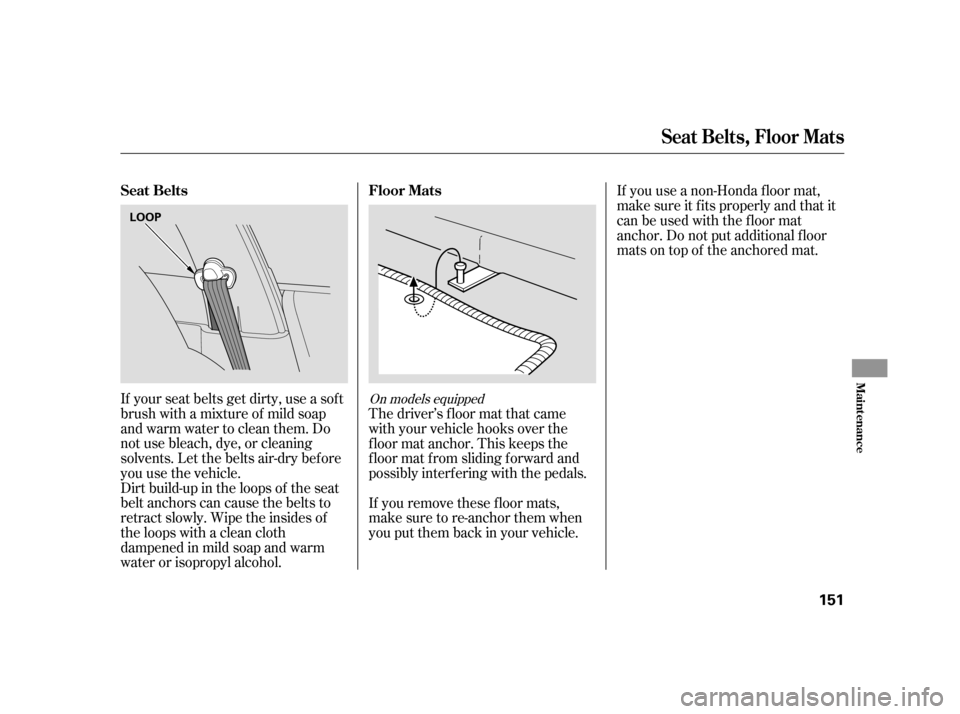
If your seat belts get dirty, use a sof t
brush with a mixture of mild soap
and warm water to clean them. Do
not use bleach, dye, or cleaning
solvents. Let the belts air-dry bef ore
you use the vehicle.
Dirt build-up in the loops of the seat
belt anchors can cause the belts to
retract slowly. Wipe the insides of
the loops with a clean cloth
dampened in mild soap and warm
water or isopropyl alcohol.The driver’s f loor mat that came
with your vehicle hooks over the
f loor mat anchor. This keeps the
f loor mat f rom sliding f orward and
possibly interf ering with the pedals.
If you remove these f loor mats,
make sure to re-anchor them when
you put them back in your vehicle.If you use a non-Honda f loor mat,
make sure it f its properly and that it
canbeusedwiththefloormat
anchor. Do not put additional f loor
mats on top of the anchored mat.On models equipped
Seat Belt s, Floor Mat s
Seat Belts
Floor Mats
Maint enance
151
LOOP
Page 153 of 218
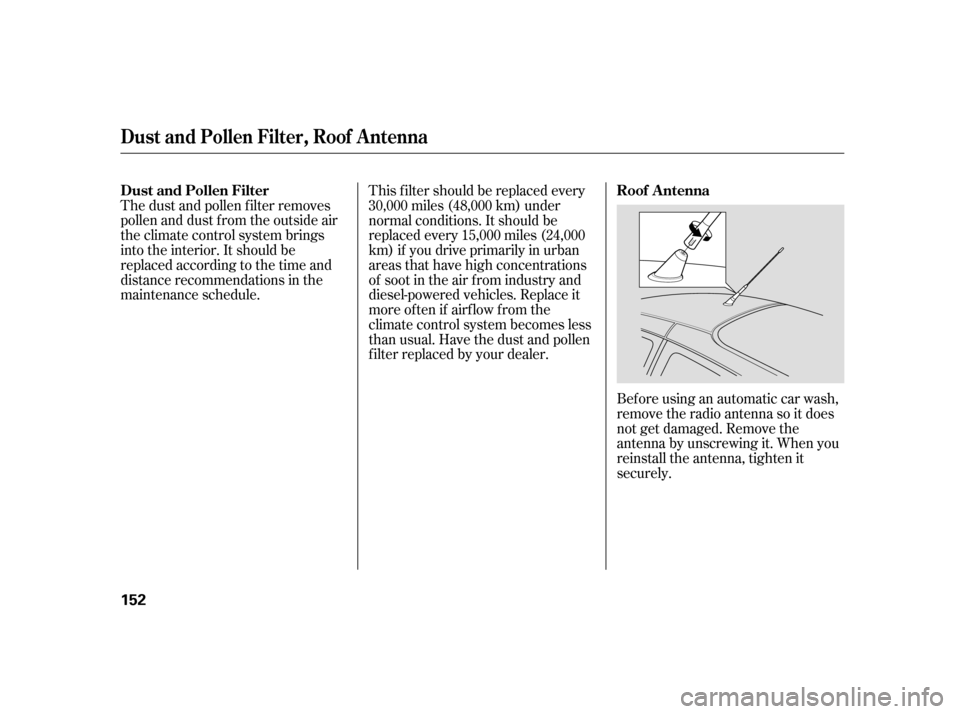
Beforeusinganautomaticcarwash,
remove the radio antenna so it does
not get damaged. Remove the
antenna by unscrewing it. When you
reinstall the antenna, tighten it
securely.
The dust and pollen f ilter removes
pollen and dust f rom the outside air
the climate control system brings
into the interior. It should be
replaced according to the time and
distance recommendations in the
maintenance schedule.
This f ilter should be replaced every
30,000 miles (48,000 km) under
normal conditions. It should be
replaced every 15,000 miles (24,000
km) if you drive primarily in urban
areas that have high concentrations
of soot in the air f rom industry and
diesel-powered vehicles. Replace it
more of ten if airf low f rom the
climate control system becomes less
than usual. Have the dust and pollen
f ilter replaced by your dealer.Roof A ntenna
Dust and Pollen Filter
Dust and Pollen Filt er, Roof A nt enna
152
Page 154 of 218
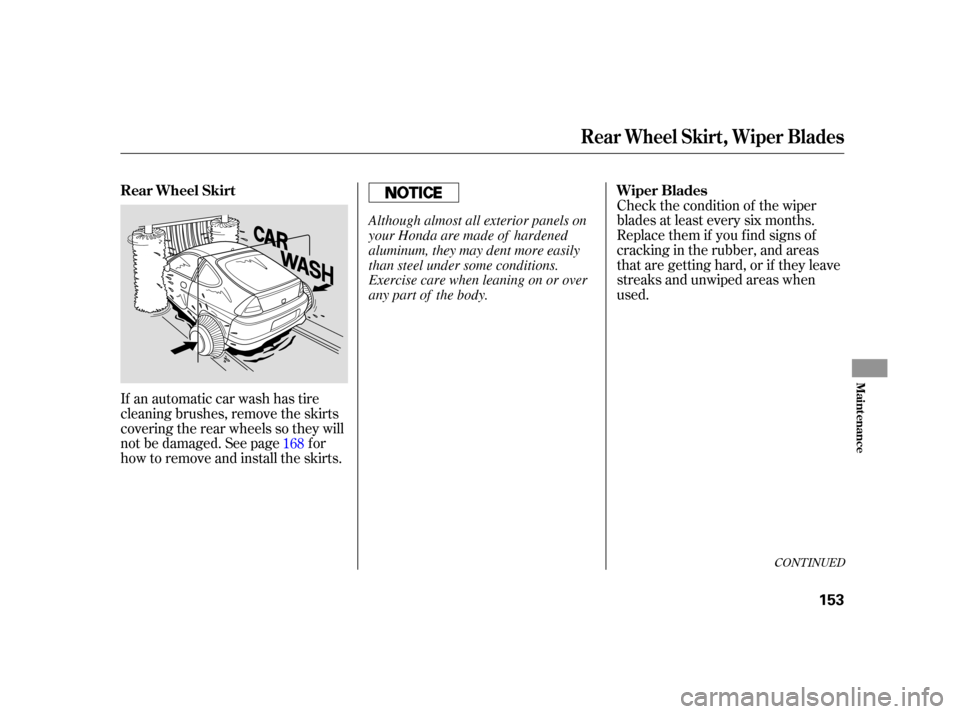
If an automatic car wash has tire
cleaning brushes, remove the skirts
covering the rear wheels so they will
not be damaged. See page f or
how to remove and install the skirts.Check the condition of the wiper
blades at least every six months.
Replace them if you f ind signs of
cracking in the rubber, and areas
that are getting hard, or if they leave
streaks and unwiped areas when
used.
168
CONT INUED
Rear Wheel Skirt, Wiper Blades
Rear Wheel Skirt Wiper Blades
Maint enance
153
Although almost all exterior panels on
your Honda are made of hardened
aluminum, they may dent more easily
than steel under some conditions.
Exercise care when leaning on or over
any part of the body.
Page 155 of 218
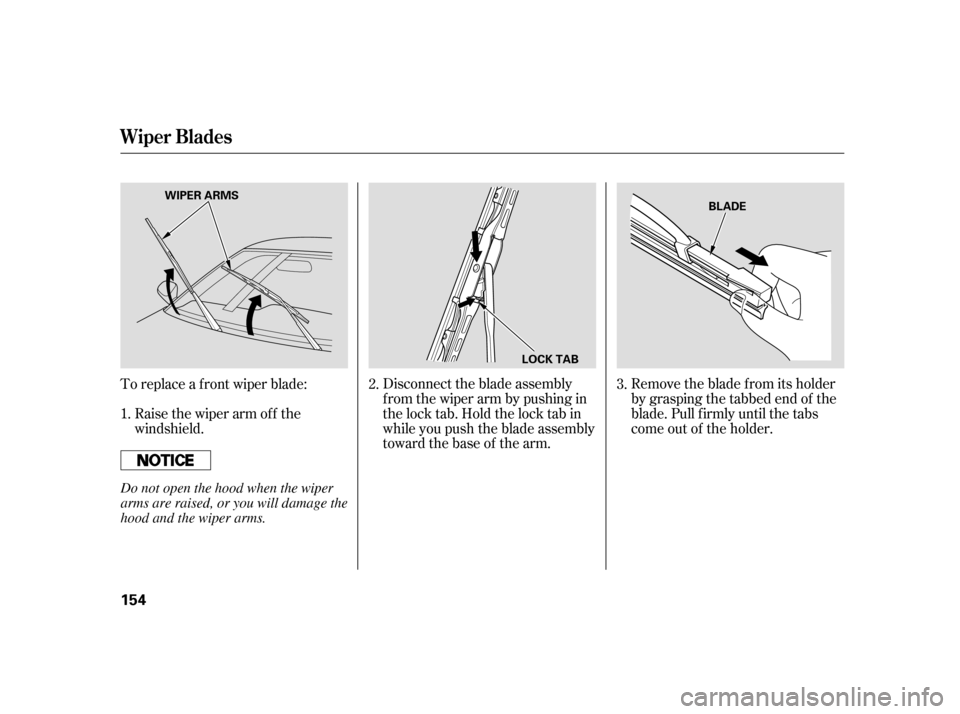
Disconnect the blade assembly
fromthewiperarmbypushingin
the lock tab. Hold the lock tab in
while you push the blade assembly
toward the base of the arm.Remove the blade f rom its holder
by grasping the tabbed end of the
blade. Pull f irmly until the tabs
come out of the holder.
To replace a f ront wiper blade:
Raise the wiper arm of f the
windshield. 2.
3.
1.
Wiper Blades
154
LOCK TAB BLADE
WIPER ARMS
Do not open the hood when the wiper
arms are raised, or you will damage the
hood and the wiper arms.
Page 156 of 218
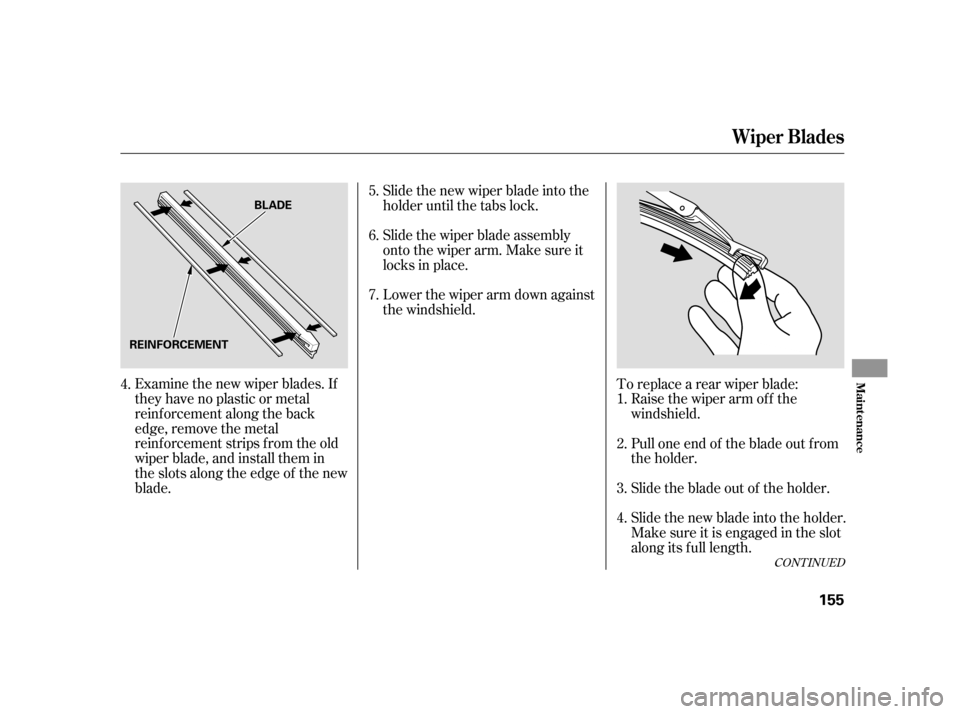
Examine the new wiper blades. If
they have no plastic or metal
reinf orcement along the back
edge, remove the metal
reinf orcement strips f rom the old
wiper blade, and install them in
the slots along the edge of the new
blade.Slide the new wiper blade into the
holder until the tabs lock.
Slide the wiper blade assembly
onto the wiper arm. Make sure it
locks in place.
Lower the wiper arm down against
the windshield.
To replace a rear wiper blade:Raise the wiper arm of f the
windshield.
Pull one end of the blade out f rom
the holder.
Slide the blade out of the holder.
Slide the new blade into the holder.
Make sure it is engaged in the slot
along its f ull length.
4. 5.
6.
7.
1.
2.
3.
4.
CONT INUED
Wiper Blades
Maint enance
155
BLADE
REINFORCEMENT
Page 157 of 218

Insert both ends of the blade into
the holder. Make sure they are
secure.
Slide the wiper blade assembly
onto the wiper arm. Make sure it
locks in place.
Lower the wiper arm.To saf ely operate your vehicle, your
tires must be the proper type and
size, in good condition with adequate
tread, and correctly inf lated.
The f ollowing pages give more
detailed inf ormation on how to take
care of your tires and what to do
when they need to be replaced.
Keeping the tires properly inf lated
provides the best combination of
handling, tread lif e, and riding
comf ort.
Underinf lated tires wear unevenly,
adversely af f ect handling and f uel
economy, and are more likely to
fail from being overheated.
Overinf lated tires can make your
vehicleridemoreharshly,are
more prone to damage f rom road
hazards, and wear unevenly.
We recommend that you visually
check your tires every day. If you
think a tire might be low, check it
immediately with a tire gauge.
5.
6.
7.
Wiper Blades, Tires
T ires
Inf lation Guidelines
156
Using tires that are excessively
worn or improperly inflated can
cause a crash in which you can
be seriously hurt or killed.
Follow all instructions in this
owner’s manual regarding tire
inflation and maintenance.
Page 158 of 218

Use a gauge to measure the air
pressure at least once a month. Even
tires that are in good condition may
lose one to two psi (10 to 20 kPa, 0.1
to 0.2 kgf /cm ) per month.
Remember to check the spare tire at
thesametime.
Check the pressure in the tires when
they are cold. This means the vehicle
has been parked f or at least three
hours, or driven less than 1 mile (1.6
km).If you check the pressure when the
tires are hot [driven f or several miles
(kilometers)], you will see readings 4
to6psi(30to40kPa,0.3to0.4
kgf /cm ) higher than the cold
reading. This is normal; do not
release air to match the cold
pressure.
The following chart shows the
recommended cold tire pressures f or
most normal driving conditions.
Thecompactsparetirepressureis:
For convenience, the recommended
tire sizes and cold air pressures are
on a label on the driver’s doorjamb.
For additional technical information,
see page .
Add or release air, if needed, to
match the recommended cold tire
pressuresonthispage.
Youshoulduseyourowntire
pressure gauge whenever you check
your tire pressures. This will make it
easier f or you to tell if a pressure
loss is due to a tire problem and not
due to a variation between gauges.
While tubeless tires have some
ability to self -seal if they are
punctured, you should look closely
for punctures if a tire starts losing
pressure.
196
Tire Size Cold Tire Pressurefor Normal Driving
Front:
Rear:
Tires
Recommended T ire Pressures
Maint enance
157
60 psi (420 kPa , 4.2 kgf/cm)
38 psi (260 kPa ,2.6 kgf/cm
)
35 psi (240 kPa , 2.4 kgf/cm
)
P165/65R14 78S
Page 159 of 218
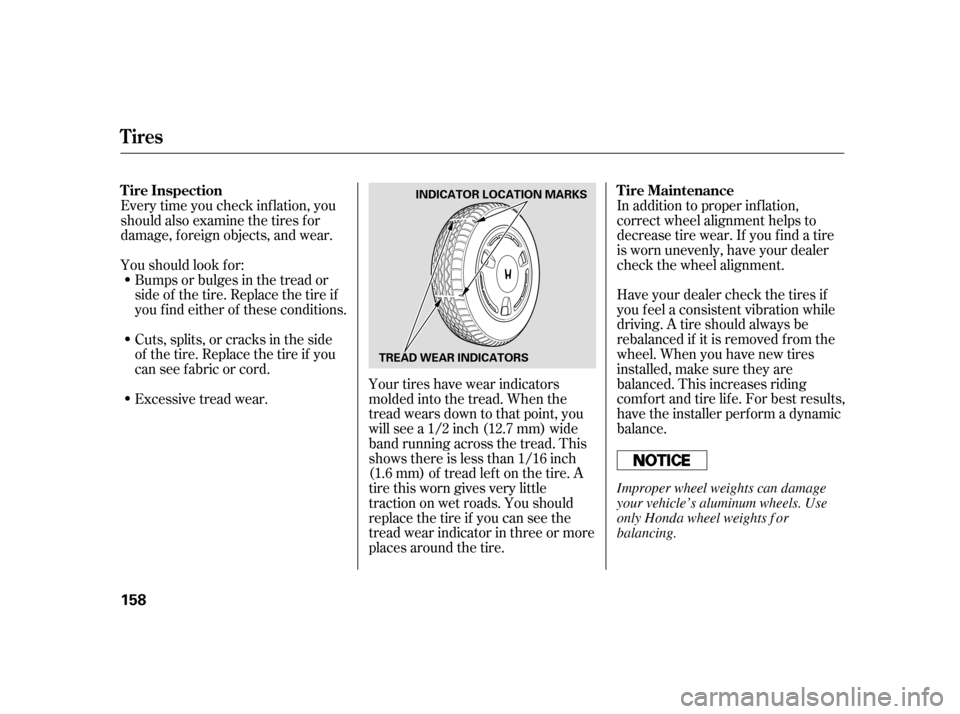
Have your dealer check the tires if
you f eel a consistent vibration while
driving. A tire should always be
rebalanced if it is removed f rom the
wheel. When you have new tires
installed, make sure they are
balanced. This increases riding
comf ort and tire lif e. For best results,
have the installer perform a dynamic
balance. In addition to proper inf lation,
correct wheel alignment helps to
decrease tire wear. If you f ind a tire
is worn unevenly, have your dealer
check the wheel alignment.
Every time you check inf lation, you
should also examine the tires f or
damage, f oreign objects, and wear.
Youshouldlookfor:
Bumps or bulges in the tread or
side of the tire. Replace the tire if
youfindeitherof theseconditions.
Cuts, splits, or cracks in the side
of the tire. Replace the tire if you
can see f abric or cord.
Excessive tread wear. Your tires have wear indicators
molded into the tread. When the
tread wears down to that point, you
will see a 1/2 inch (12.7 mm) wide
band running across the tread. This
shows there is less than 1/16 inch
(1.6 mm) of tread lef t on the tire. A
tire this worn gives very little
traction on wet roads. You should
replace the tire if you can see the
tread wear indicator in three or more
places around the tire.
Tires
T ire Maintenance
Tire Inspection
158
INDICATOR LOCATION MARKS
TREAD WEAR INDICATORS
Improper wheel weights can damage
your vehicle’s aluminum wheels. Use
only Honda wheel weights f or
balancing.
Page 160 of 218
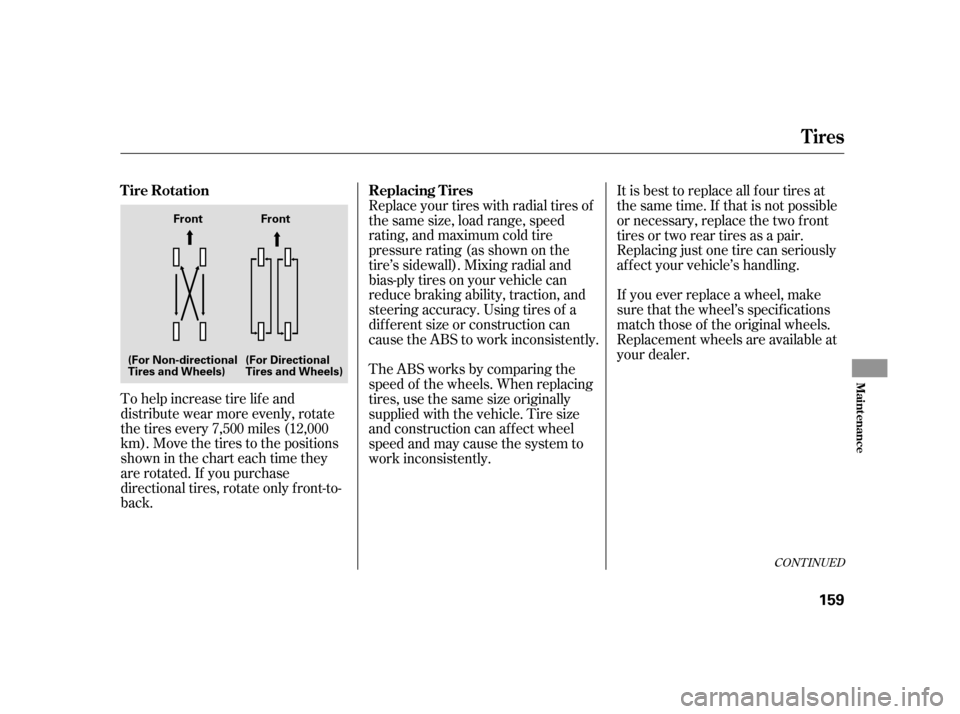
To help increase tire lif e and
distribute wear more evenly, rotate
the tires every 7,500 miles (12,000
km). Move the tires to the positions
showninthecharteachtimethey
are rotated. If you purchase
directional tires, rotate only f ront-to-
back.Replace your tires with radial tires of
the same size, load range, speed
rating, and maximum cold tire
pressure rating (as shown on the
tire’s sidewall). Mixing radial and
bias-ply tires on your vehicle can
reduce braking ability, traction, and
steering accuracy. Using tires of a
dif f erent size or construction can
cause the ABS to work inconsistently.
It is best to replace all f our tires at
thesametime.If thatisnotpossible
or necessary, replace the two f ront
tires or two rear tires as a pair.
Replacing just one tire can seriously
af f ect your vehicle’s handling.
If you ever replace a wheel, make
sure that the wheel’s specif ications
match those of the original wheels.
Replacement wheels are available at
your dealer.
TheABSworksbycomparingthe
speed of the wheels. When replacing
tires, use the same size originally
supplied with the vehicle. Tire size
and construction can affect wheel
speed and may cause the system to
work inconsistently.
CONT INUED
Tires
Tire Rotation Replacing Tires
Maint enance
159
Front Front
(For Non-directional
Tires and Wheels) (For Directional
Tires and Wheels)